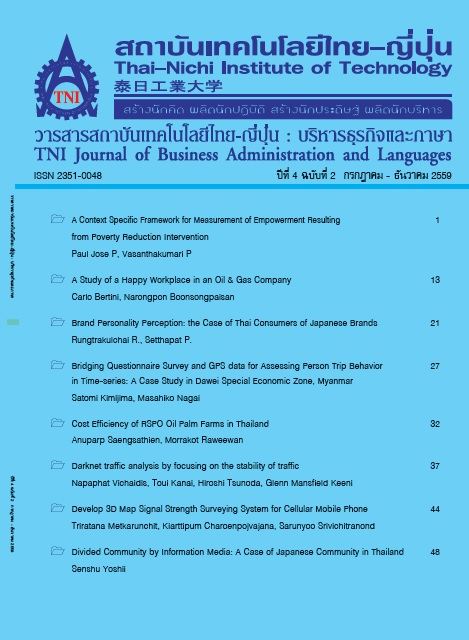Cost Efficiency of RSPO Oil Palm Farms in Thailand
Main Article Content
Abstract
According to Roundtable on Sustainable Palm Oil (RSPO), Thailand is the first oil palm producer in the world to achieve independent smallholders RSPO-certified under the RSPO Group Certification in 2012. The purpose of this study is to measure cost efficiency and to identify factors affecting cost efficiency in RSPO oil palm plantation in Thailand. The RSPO record book from 2014 was analyzed using data envelopment analysis method in value-based cost efficiency model of Tone (2002). The estimated cost efficiency of RSPO oil palm farms was found to be 62.66 percent with a minimum of 32.42 percent and a maximum of 100 percent. The result of this study revealed that the important factors affecting positive relationship on cost efficiency are applied empty fresh fruit bunch and paid for water supply.
Article Details
Article Accepting Policy
The editorial board of Thai-Nichi Institute of Technology is pleased to receive articles from lecturers and experts in the fields of business administration, languages, engineering and technology written in Thai or English. The academic work submitted for publication must not be published in any other publication before and must not be under consideration of other journal submissions. Therefore, those interested in participating in the dissemination of work and knowledge can submit their article to the editorial board for further submission to the screening committee to consider publishing in the journal. The articles that can be published include solely research articles. Interested persons can prepare their articles by reviewing recommendations for article authors.
Copyright infringement is solely the responsibility of the author(s) of the article. Articles that have been published must be screened and reviewed for quality from qualified experts approved by the editorial board.
The text that appears within each article published in this research journal is a personal opinion of each author, nothing related to Thai-Nichi Institute of Technology, and other faculty members in the institution in any way. Responsibilities and accuracy for the content of each article are owned by each author. If there is any mistake, each author will be responsible for his/her own article(s).
The editorial board reserves the right not to bring any content, views or comments of articles in the Journal of Thai-Nichi Institute of Technology to publish before receiving permission from the authorized author(s) in writing. The published work is the copyright of the Journal of Thai-Nichi Institute of Technology.
References
D. Jonas, “Oil palm development in Thailand: economic, social and environmental considerations,” in Oil Palm Expansion in South East Asia: trends and implications for local communities and indigenous peoples, Forest Peoples Programme, 2011, p. 249.
W. Ubolrat and Y. Nantakrit, “Current Situation of RSPO Standard to Smallholder Farmers in Thailand,” European Journal of Scientific Research, vol. 113, no. 3, pp. 466–479, 2013.
B. F. Emily, J. S. Matthew, M. Alexandra, D. Finn, A. B. Carsten, F. D. Paul, and P. Ben, “How will oil palm expansion affect biodiversity?,” Trends in Ecology & Evolution, vol. 23, no. 10, pp. 538–545, 2008
T. Sutonya and K. Sirirat, “Final Report : Impact Study of the Project on Sustainable Palm Oil Production for Bio-energy in Thailand,” GIZ Thailand: Project of Sustainable Palm Oil Production for Bio-Energy, Prince of Songkla University and Office of Agricultural Economics, 2012.
B. H. Gabdo, “Estimation of cost and allocative efficiencies under smallholder livestock-oil palm integration farms in Johor, Malaysia.,” Agricultural Journal, vol. 8, no. 6, pp. 304–307, 2013
E. Gundogmus and Z. Bayramoglu, “Cost efficiency on organic farming: a comparison between organic and conventional raisin-producing households in Turkey,” Spanish Journal of Agricultural Research, vol. 6, no. 1, 2008.
O. Ibitoye, A. Akinsorotan, N. Meludu, and B. Ibitoye, “Factors Affecting Oil Palm Production in Ondo State of Nigeria,” Journal of Agriculture and Social Research (JASR), vol. 11, no. 1,pp. 97–105, 2011.
M. Henny and A. Desi, “Efficiency Analysis of Palm Plantation Plasma Farmers Certified Repo and without Repo on Sustainable Palm Plantation Management in Musi Banyuasin Regency South Sumatera Indonesia,” in IPCBEE, Kuala Lumpur, Malaysia, 2012, vol. 33, pp. 194–199.
K. Tone, “A Strange Case of the Cost and Allocative Efficiencies in DEA,” The Journal of the Operational Research Society, vol. 53, no. 11, pp. 1225–1231, 2002.
M. J. Farrell, “The Measurement of Productive Efficiency,” Journal of the Royal Statistical Society. Series A (General), vol. 120, no. 3, pp. 253–290, 1957.
R. Färe, S. Grosskopf, and C. A. K. Lovell, The Measurement of Efficiency of Production. Boston: Kluwer-Nijhoff Pub, 1985.
B. K. Sahoo, M. Mehdiloozad, and K. Tone, “Cost, revenue and profit efficiency measurement in DEA: A


